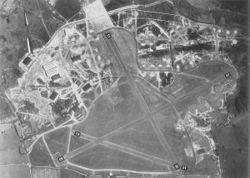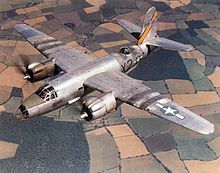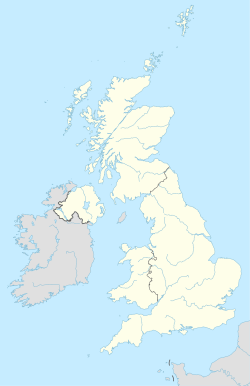Royal Air Force Hurn or more simply RAF Hurn is a former Royal Air Force station located approximately 4 miles (6.4 km) north west of Christchurch, Dorset, England
| RAF Hurn USAAF Station AAF-492 | |||||||||||
|---|---|---|---|---|---|---|---|---|---|---|---|
| Bournemouth, Dorset in England | |||||||||||
 Hurn airfield photographed in May 1947 still showing its Second World War configuration | |||||||||||
| Coordinates | 50°46′54″N 001°50′23″W / 50.78167°N 1.83972°W | ||||||||||
| Type | Royal Air Force station | ||||||||||
| Code | KU[1] | ||||||||||
| Site information | |||||||||||
| Owner | Air Ministry | ||||||||||
| Operator | Royal Air Force United States Army Air Forces 1944 | ||||||||||
| Controlled by | RAF Fighter Command 1941-44 * No. 11 Group RAF Ninth Air Force | ||||||||||
| Site history | |||||||||||
| Built | 1940/41 | ||||||||||
| In use | July 1941 - 1946 | ||||||||||
| Battles/wars | European theatre of World War II | ||||||||||
| Airfield information | |||||||||||
| Elevation | 10 metres (33 ft)[1] AMSL | ||||||||||
| |||||||||||




Opened in 1941, it was used by both the Royal Air Force and United States Army Air Forces. During the war it was used primarily as a transport and fighter airfield.
Hurn was the final airfield in England for aircraft flying to Morocco for the North African and Italian campaigns, avoiding France, Spain and Portugal airspace.
Since 1969, it has also been called Bournemouth Airport. The RAF have returned to Hurn in the form of a temporary Outsourcing Contract for Multi-Engine Pilot Training to cope with limited capacity through normal Training Provisions using L3 Harris Airline Academy (2018 -).
RAF use
editThe following squadrons were here at some point[2]
- No. 88 Squadron RAF
- No. 125 Squadron RAF (1944)
- No. 170 Squadron RAF
- No. 198 Squadron RAF (1944)
- No. 239 Squadron RAF
- No. 263 Squadron RAF (1944)
- No. 277 Squadron RAF
- No. 295 Squadron RAF
- No. 296 Squadron RAF
- No. 297 Squadron RAF
- No. 412 Squadron RCAF (1943)
- No. 418 Squadron RCAF (1944)
- No. 570 Squadron RAF
- No. 604 Squadron RAF (1944)
- No. 609 Squadron RAF
- No. 620 Squadron RAF
Units:[2]
- No. 2 Air Experience Flight RAF
- No. 3 Overseas Aircraft Despatch Unit
- No. 16 (Mobile Fighter) Wing RAF
- No. 19 (Fighter) Sector
- No. 20 (Fighter) Sector
- No. 22 (RCAF) (Fighter) Sector
- No. 22 (RCAF) (Fighter) Wing RAF
- No. 124 Airfield became No. 124 (Rocket Projectile) Wing RAF[3]
- No. 181 Squadron RAF (1944)
- No. 182 Squadron RAF (1944)
- No. 247 Squadron RAF (1944)
- No. 136 (Fighter) Wing RAF[3]
- No. 164 Squadron RAF (1944)
- No. 183 Squadron RAF (1944)
- No. 143 (RCAF) Airfield became No. 143 (RCAF) (Fighter) Wing RAF[3]
- No. 438 Squadron RCAF (1944)
- No. 439 Squadron RCAF (1944)
- No. 440 Squadron RCAF (1944)
- No. 146 (Fighter) Wing RAF[3]
- No. 193 Squadron RAF (1944)
- No. 197 Squadron RAF (1944)
- No. 257 Squadron RAF (1944)
- No. 266 Squadron RAF (1944)
- No. 403 Repair & Salvage Unit
- No. 419 (RCAF) Repair & Salvage Unit
- No. 1302 Mobile Wing RAF Regiment
- No. 1498 (Target Towing) Flight RAF
- No. 2739 Squadron RAF Regiment
- No. 2742 Squadron RAF Regiment
- No. 2768 Squadron RAF Regiment
- No. 2773 Squadron RAF Regiment
- No. 2794 Squadron RAF Regiment
- No. 2796 Squadron RAF Regiment
- No. 3206 Servicing Commando
- Heavy Glider Maintenance Unit
- Southampton University Air Squadron
USAAF use
editHurn was known as USAAF Station AAF-492 for security reasons by the USAAF during the war, and by which it was referred to instead of location. Its USAAF Station Code was "KU".
422nd Night Fighter Squadron
editOn 28 June 1944, Northrop P-61 Black Widow night fighters of the 422nd Night Fighter Squadron arrived from RAF Scorton, where their crews had been tutored in this particular aspect of air combat by the RAF. The detachment commenced operational flying on 3 July only to return to Scorton a week later.
397th Bombardment Group
editOn 5 August the 397th Bombardment Group arrived from RAF Rivenhall, equipped with Martin B-26 Marauders. The group consisted of the following operational squadrons:
- 596th Bombardment Squadron (X2)
- 597th Bombardment Squadron (9F)
- 598th Bombardment Squadron (U2)
- 599th Bombardment Squadron (6B)
The group's identification marking was a yellow diagonal band across both sides of the vertical tailplane. It moved the Advanced Landing Ground at Gorges, France, (A-26) on 19 August
The airfield was closed by the RAF in October 1944 and turned over for civil use.
See also
editReferences
editThis article incorporates public domain material from the Air Force Historical Research Agency
- ^ a b Falconer 2012, p. 115.
- ^ a b "Hurn (Bournemouth)". Airfields of Britain Conservation Trust. Retrieved 23 April 2022.
- ^ a b c d Falconer 1998, p. 123.
- Freeman, Roger A. (1994) UK Airfields of the Ninth: Then and Now 1994. After the Battle ISBN 0-900913-80-0
- Freeman, Roger A. (1996) The Ninth Air Force in Colour: UK and the Continent-World War Two. After the Battle ISBN 1-85409-272-3
- Falconer, J (1998). RAF Fighter Airfields of World War 2. UK: Ian Allan Publishing. ISBN 0-7110-2175-9.
- Maurer, Maurer (1983). Air Force Combat Units Of World War II. Maxwell AFB, Alabama: Office of Air Force History. ISBN 0-89201-092-4.
- ControlTowers.co.uk http://www.controltowers.co.uk/H-K/Hurn.htm
- USAAS-USAAC-USAAF-USAF Aircraft Serial Numbers--1908 to present


